by Lorna McDowell, studio photos by Laura Schaeffer // Dec. 12, 2023
“This is care in action!” exclaims Cibelle Cavalli Bastos, as they serve us steaming hot tea soon after we arrive at their studio in Köpenick, a lushly forested neighbourhood in south-east Berlin. Bastos’ studio is tucked away on the third floor of a large commercial building. After venturing up multiple flights of stairs, we are warmly welcomed inside. The notion of care is important to Bastos, and we quickly dive deep into a conversation about its lack of value in the belief systems that uphold our society. “I tie everything back to the core issue of femmephobia,” Bastos says. “The patriarchal psyche of our society is grounded in looking down upon anything at all that is associated with the feminine—compassion, empathy, being present with each other.”
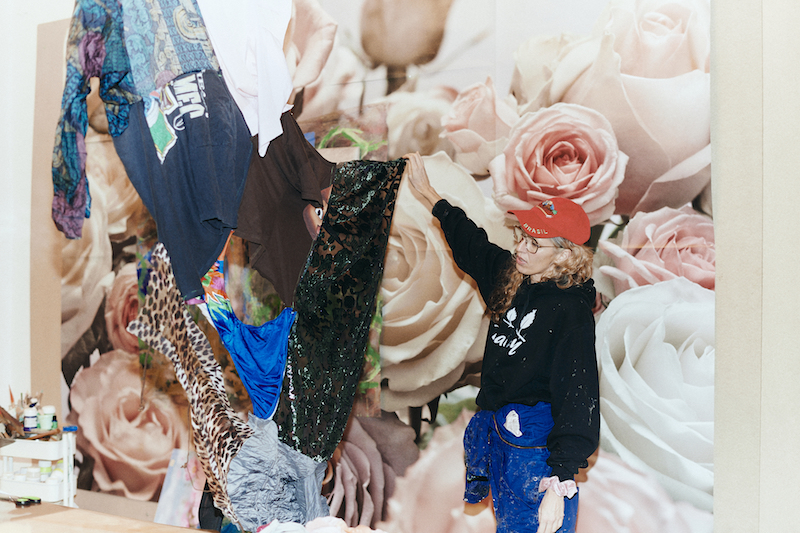
Intuition, the embodied feeling that is often ascribed and detracted as feminine, is probably the most crucial element of Bastos’ practice. “My whole body is like ‘this goes here’,” they gesture randomly. “I have to really disengage from my analysis and my left brain and just let it happen.” The artist left their home country of Brazil in 2001 and has rarely been back, but still wonders if their tendency to stack and collect found materials and readymades, to “work with what you have,” so to speak, indicates a Brazilian sensibility, or simply an neo-concretist influence seeping through.

One wall of Bastos’ studio is lined with a huge piece of mass-produced wallpaper, featuring large-scale roses in an almost dreamy but restrained colour palette of soft pinks and greys, and overlaid with a smaller painting that pops with lurid green and blue scrawl. This is the process wall, where works are made and composited and amalgamated. It’s the wall of experimentation, Bastos tells us. The wall opposite is the space for pseudo-finished work, where many works go into a space for contemplation, and from there sometimes they go back to the other wall. It’s currently dotted with belts that hang and curl sculpturally. On this wall, Bastos comes to perceptively understand and link the evolving visual gestures in their work. They liken the process of placing the materials on the wall to tarot card reading, a process of divination that works by confirming what intuition and the right side of the brain already know. “I’m obsessed with salon hangs. I love it, because with a practice like mine, form really navigates. You find the commonality in the gesture, in the materials, but it’s not necessarily like everything is gonna look very similar. And when you do a salon hang… it’s easier to pinpoint the thread.”
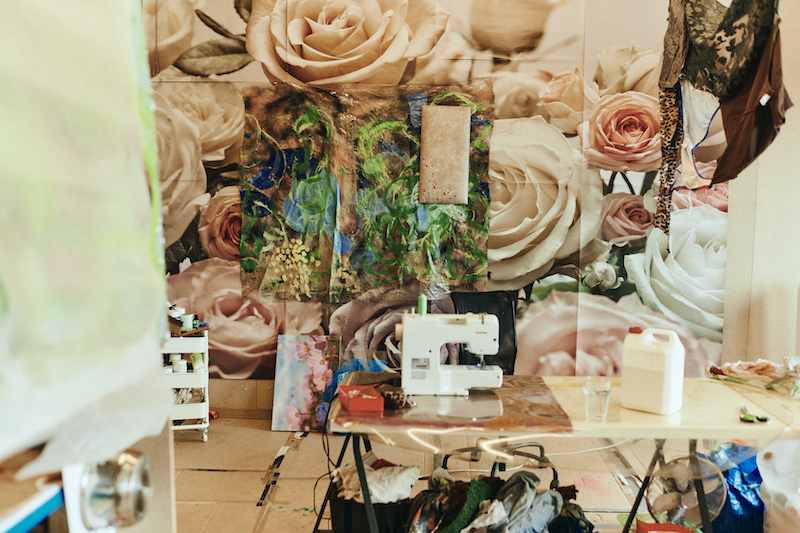
In the middle of the room, a sewing machine and bottle of latex liquid are placed on a worktable. Underneath it, there are bags overflowing with Bastos’ old clothes and fabrics, which they believe carry an emotional and historical charge. Multiple washing lines hang across the high ceiling overhead, where Bastos hangs sculptural garments they create from patching the clothes together, purely by gut feeling and without any vision for how they might turn out. The garments are then embedded with latex, which takes a while to dry out. Anything that Bastos works with that isn’t found or readymade is likely to be highly toxic and ammonia-laden—latex, resin, spray paint, solvents, styrofoam—so any food brought into the studio needs to be secured in containers. It’s undecided if the garment currently hanging from one of the lines above will become something Bastos will wear for an upcoming performance at Kindl. Sometimes, these textile pieces are painted and become something else.“ I like to re-show things and sometimes exhibit them modified or re-contextualized. I don’t like this idea of ‘it’s better because it’s new,’” Bastos explains.
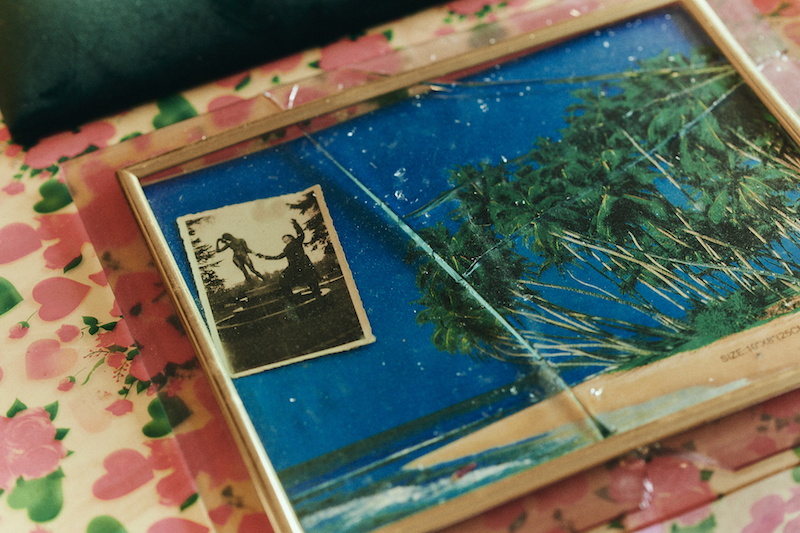
In the past, Bastos has created work that was more didactic, communicating about the supremacism, classism and environmental destruction that stem from the femmephobia they describe. “But I realised I was in an echo chamber and talking to people who were already aware, and that using the exact words—calling a cat a cat—was triggering the people that really need to understand these things.” Now, instead, they “pretend” to talk about art, formalism, polymorphs, machine learning, as props and metaphors for entering into these political topics. Right down to the essence of the found and ready-made materials they work with, Bastos’ style goes against the culture of formalism that emerges from our capitalist society. They deliberately combine materials such as oil-cloth, glitter, baumarkt materials, online orders and the aforementioned mass-produced “shitty wallpaper.” There’s a language to some of the materials Bastos works with, the porousness of net or foam, for example, which they believe aligns with their approach to both life and practice—a spiritual ethos of openness, non-attachment and flow.
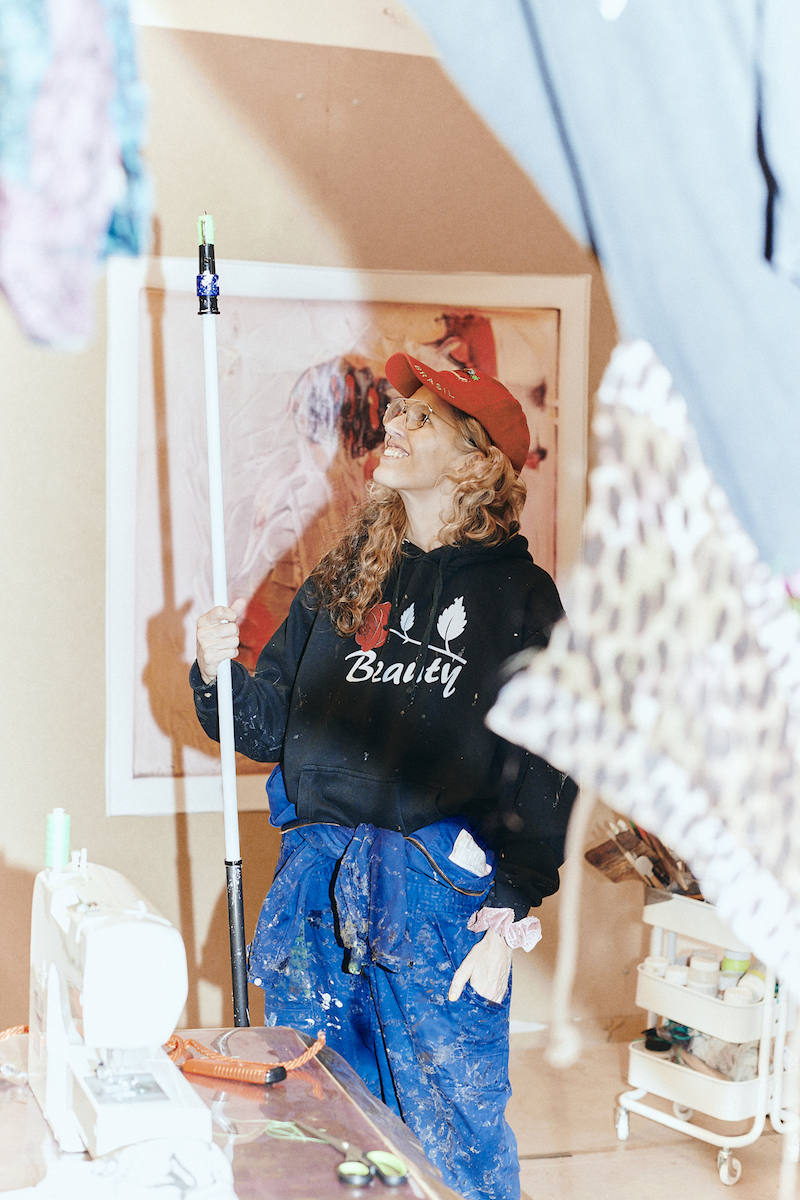
Bastos undertook a master’s degree in painting at the Royal College of Art, and is therefore no stranger to traditional, hierarchical approaches to creating across various mediums, but chooses not to engage them consciously in practice. Their profound distrust of the left brain and its social conditioning makes them wary about consciously engaging with composition or colour. In a hierarchical and white supremacist society, which is also classist and colonial, we might internalise voices that instinctively deem colourful artworks “childlike” or of “naïve.” Bastos does all they can to avoid such artistic dogma—when painting, they gather paints together, look away and choose colours at random. “I have to deal with it and find harmony with whatever I find. This is why I call it ‘pain’-ting, with what might be a horrific palette of colours…when I’m painting, that’s when I go into the meditative state that allows me to talk about everything I’ve mentioned, the social, the political.” Bastos mentions that people sometimes describe their work as abstract expressionism, but disagrees with this evaluation. “It’s extraction,“ they suggest. “Expressionist extraction, or something like that. I’m trying to empty myself, empty my mind, and then I can look at everything that came out.“ Coincidentally, and perhaps by some kind of cosmic entanglement, some of Bastos’ cohort at the RCA also took this approach of a “thinking practice,” of which painting is a part, a process, but not the end goal.
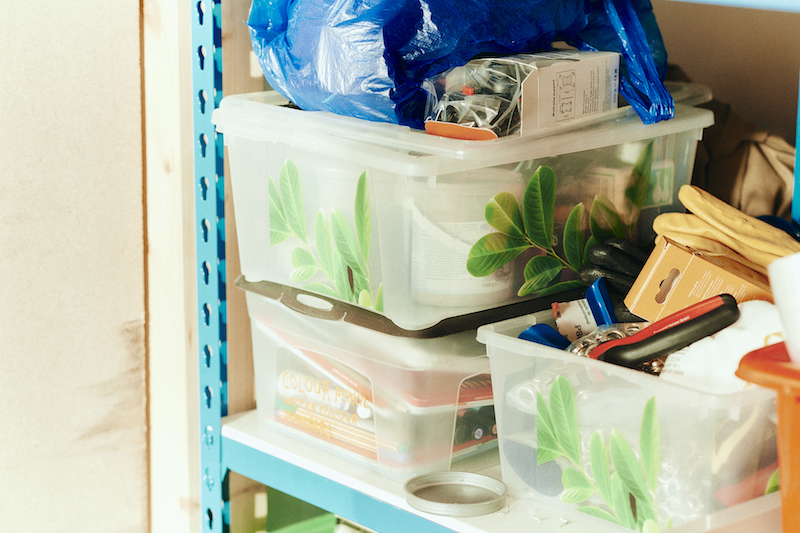
Throughout the hour or two that pass by, Bastos occasionally refers back to the machine learning artworks saved on their laptop, opening up the files and pressing play as a backdrop to our conversation. Textures move and dapple across the screen. Bastos has worked with tech language for a long time, referring to the body as an avatar interface and challenging common understandings of subjectivity. Speaking of entanglement, working with AI is, for Bastos, literally conversing with the collective unconscious: “the good, the bad and the ugly.” Bastos’ recent show at Galerie Wedding, ‘Polymorph,’ features an enormous wallpaper of around 14 meters in size that merges temporalities. Bastos hails the fact that AI allows you to smoothly delete parts, add parts and prompt things. In creating the wallpaper, Bastos merged 360° scans of their various studios over the years—scans taken on very ordinary, run-of-the-mill days, aligning with their non-hierarchical approach to working. A floor from Paris ends up between Köpenick and London. Some works are deleted from the scene and put in again using prompts based on formal descriptions of Bastos’ works, for example, “biomorphic postmodern sculpture made of plastic bags and foam.” People like to talk about AI and digital works as “not real” and physical works as “real” and Bastos enjoys that when actually looking at their work in a photo or on social media, the same people can’t tell which is which.
At Galerie Wedding, Bastos applied a 3D 360° image to a curved wall, playing with perception and creating a disorientating effect, whereby you’re not sure if the paper is flat or the wall is looming more forwards. Bastos plays with reality further by embedding images of physical works into the wallpaper in places where the light hits the surface in such a way that adds depth, creating the illusion that the work is actually in the original studio scan. ‘Polymorph’ also features moving image and machine-learning works, painterly sculptures (“or sculptural paintings”) and augmented reality accessed from QR codes that are hung as tiny paintings, and which send visitors on a side quest back to another room to augment works. Bastos works a lot with augmented reality: “metaphorically, it means a lot to me. I think tacitly it’s a way to make people understand that there is much more beyond what we see with the naked eye.” Speaking about technology as a mediation for accessing reality, Bastos explains, here we are perceiving reality by the technology of our brains, the light hitting particles, the nerve endings in our eyes that take information and send it to our visual cortex. “We believe we’re seeing everything, but we’re not seeing the wifi, for example,“ they remark. It’s not hard to conclude that there’s so much we don’t see, and returning to the real-not-real dichotomy, Bastos firmly believes that if you create an AR sculpture and position it according to GPS, it really exists. AR is a metaphor for talking about how we perceive each other too, as psychologically, we’re always adding our own layers to reality based on past experiences or prior knowledge.

The rain has stopped falling and the winter sun sears through the clouds and in through the large windows of Bastos’ studio. It’s almost time to wrap up the afternoon, but not before taking a visit to the virtual reality rendition of the ‘Polymorph‚’ exhibition, which exists in the metaverse and replicates the hanging that exists “IRL.” Bastos patiently sets up and demonstrates the headset, and before long I’ve entered into a cartoonish avatar body and am able to move around the exhibition space, interacting with artworks and another identical avatar, which is Bastos, who joins me by accessing the space in 2D from their laptop. We take turns encountering and interacting with each other, in a realm that we might now accept as no more or less real than any other.



















